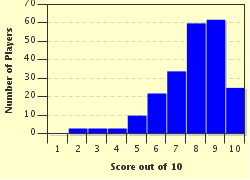Quiz Answer Key and Fun Facts
1. What sort of things is quantum mechanics all about?
2. What does the word "quantum" mean? (Clue: it is related to the word "quantity".)
3. What does the word "mechanics" mean, in the context of quantum mechanics?
4. If we are secretly watching cars driving up to a junction, does the fact that we are watching them influence whether the drivers turn left or right?
5. One important idea in quantum mechanics involved scientists trying to work out whether light is individual particles (like jelly beans) or continuous waves (like a licorice lace). What do you think they found out?
6. What is the "photoelectric effect"?
7. Think of two particles as being like two unconnected coins which are miles apart. A scientist knows that one particle is showing "heads". Does this mean he automatically knows what the other particle is showing?
8. Which of the following illustrates the Heisenberg Uncertainty Principle?
9. Assume there is a 50% probability (or chance) that a particle is in place A. Now a scientist looks in place A and sees the particle there. What is the probability that the particle is in place A?
10. In normal, everyday life, is it possible for a fly to be both dead and alive at the same time?
Source: Author
emiloony
This quiz was reviewed by FunTrivia editor
NatalieW before going online.
Any errors found in FunTrivia content are routinely corrected through our feedback system.

